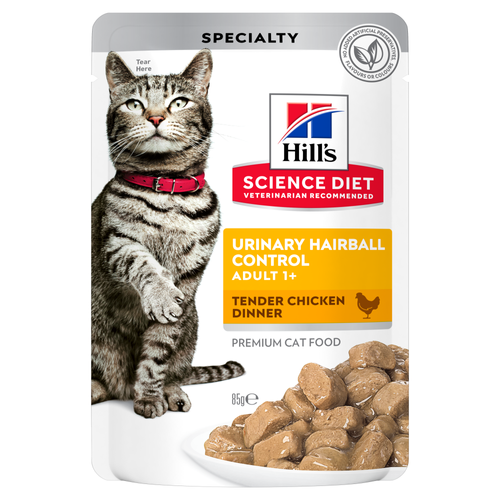
-
Find the right food for your petTake this quiz to see which food may be the best for your furry friend.Find the right food for your petTake this quiz to see which food may be the best for your furry friend.Health CategoryFeatured products
 Perfect Weight & Joint Support Large Breed Chicken & Brown Rice Recipe Dog Food
Perfect Weight & Joint Support Large Breed Chicken & Brown Rice Recipe Dog FoodThis weight management and mobility support dog food was created with Hill’s unique understanding of the biology of overweight dogs
Shop Now Adult 7+ Healthy Cuisine Roasted Chicken, Carrots & Spinach Stew Dog Food
Adult 7+ Healthy Cuisine Roasted Chicken, Carrots & Spinach Stew Dog FoodDelicious roasted chicken paired with tender vegetables in a succulent stew
Shop Now Adult Salmon & Brown Rice Recipe Dog Food
Adult Salmon & Brown Rice Recipe Dog FoodSupports lean muscle and beautiful coat for adult dogs
Shop NowFeatured products Adult Urinary Hairball Control Tender Chicken Dinner Cat Food
Adult Urinary Hairball Control Tender Chicken Dinner Cat FoodPrecisely balanced nutrition to support urinary health from kidney to bladder. With natural fibre technology to help reduce hairballs.
Shop Now Adult Perfect Weight with Chicken Cat Food
Adult Perfect Weight with Chicken Cat FoodBreakthrough nutrition for your cat’s healthy weight maintenance and long-lasting weight support
Shop Now Adult Salmon & Brown Rice Recipe Cat Food
Adult Salmon & Brown Rice Recipe Cat FoodSupports lean muscle and beautiful fur for adult cats
Shop Now -
DogCat
- Cat Tips & Articles
-
Health Category
- Weight
- Skin & Food Sensitivities
- Urinary
- Digestive
- Kidney
- Dental
- Serious Illness
-
Life Stage
- Kitten Nutrition
- Adult Nutrition
Featured articles Pet Food Storage Tips
Pet Food Storage TipsWhere you store your cat and dog food can make a big difference in the quality and freshness once it is opened. Here are some common questions and recommendations for optimal storage for all of Hill’s dry and canned cat and dog food.
Read More Water
WaterWater is the most important nutrient of all and essential for life. Animals can lose almost all their fat and half their protein and still survive, but if they lose 15% of their water, it will mean death.
Read More The Right Diet For Your Pet
The Right Diet For Your PetLearn what to look for in healthy pet food & nutrition, including ingredients, quality of the manufacturer, your pet's age, and any special needs they have.
Read More -


If you've noticed your cat has been scratching more than normal, you probably should consider that she could be hosting tiny parasites known as cat fleas.
How did your cat become infested? Now that she has them, how do you get rid of them? Read on for the answer to those questions and more about cat fleas.
How Did My Cat Get Fleas?
One study detailed in Veterinary Parasitology found a flea that could jump 19 inches in one hop, or 160 times its body length. These jumping skills help these nonflying parasites travel easily from the ground to a new host or from host to host. Animals commonly found in your backyard — such as raccoons, mice, possums and others — more than likely carry fleas and can leave behind fleas or larvae in your yard that can easily enter your home by hitchhiking on you or a dog coming in from outdoors. Fleas can easily jump from pet to pet, no matter the species. Your cat could even simply have attracted a flea by sitting peacefully in front of her favorite screened window.

Creepy Crawly Clues
Just one flea can turn into a major infestation in a short time, as a single female can lay up to fifty eggs a day, according to the University of Kentucky. The most obvious sign of a flea infestation is a cat obsessively scratching herself. Cornell University College of Veterinary Medicine writes that fleas most frequently bite cats on the back of the neck and the top of the tail head. Since they can't reach these places with their tongue while grooming, it means they have to scratch.
If you suspect your cat has fleas, run a fine-tooth comb through her coat while she stands on a white piece of paper or a white towel. If she does have fleas, you'll more than likely dislodge tiny black specks (flea feces) and maybe even a flea or two that you'll be able to easily spot on the white background. You can see fleas with the naked eye.


Tasty Tips
What Health Problems Do Fleas Cause?
Cat fleas can be more than an irritant; sometimes they can be the cause of other serious health issues. For instance, writes Cornell, fleas can transmit dog and cat tapeworm, or their bloodsucking can lead to anemia if your cat is still a lightweight kitten.
A cat with fleas can also be a danger to her human family. Cat fleas can act as agents for human diseases like toxoplasmosis.
Treating and Preventing Fleas
Ready to put the "no vacancy" sign out for these tiny freeloaders? Your first course of action is to call your vet to get advice and treatment options. Your vet might also suggest having your cat tested for tapeworm and other diseases.
Not only do you have to treat your cat, you also have to remove all pests from your home to prevent a reinfestation. It will take careful vacuuming, washing and maybe an exterminator to effectively rid your home of all pests.
You can prevent fleas from coming back by using one of the proven flea and tick repellent products on the market, even on indoor cats. Flea and tick products for pets are regulated by either the Food and Drug Administration (FDA) or the Environmental Protection Agency. Products approved by those federal regulators must show that the drug or pesticide they are marketing actually works, and that it meets up-to-date safety standards to protect pets, people and the environment. These products come in a variety of forms such as spot-on applications, pills, or collars. Make sure the repellent you choose is safe for your cat, since a dog-safe product may harm her if she licks it off her fur. It is wise to purchase your flea and tick products from your veterinarian as some over-the-counter and natural products can be ineffective or particularly harmful to certain pets.
The FDA advises treating your pet at the beginning of flea and tick season in your area, but your vet will likely recommend treating them for the entire year. Flea season typically peaks in warmer months, but in some parts of the country can last year-round. You may think you have the cleanest kitty in the world, but fleas can affect any pet. So keep a watchful eye to make sure she's happy, healthy and itch-free.


Kara Murphy is a freelance writer and pet parent who lives in Erie, Pa. She has a goldendoodle named Maddie.
Related products

Breakthrough nutrition for your cat’s healthy weight maintenance and long-lasting weight support

Precisely balanced nutrition to support urinary health from kidney to bladder. With natural fibre technology to help reduce hairballs.

Delicious turkey chunks in gravy with omega-3 fatty acids for eye health and brain development in kittens, and high-quality protein to support muscle growth. Balanced levels of minerals for strong bones and teeth.

Supports lean muscle and beautiful fur for adult cats
Related articles

HillsPet Nutrition provides information on proper nutrition, fitness and special needs in keeping your cat healthy and happy.

Being overweight puts a cat at risk for developing many serious health issues. Weight gain indicates an increase in body fat and usually results when your cat eats too much and exercises too little.

Get helpful information on proper feline oral healthcare and why it's so vital to take care of your cat's teeth.

As a responsible pet owner you owe it to yourself and your cat to understand problems associated with overweight cats.

Put your cat on a diet without them knowing
Our low calorie formula helps you control your cat's weight. It's packed with high-quality protein for building lean muscles, and made with purposeful ingredients for a flavorful, nutritious meal. Clinically proven antioxidants, Vitamin C+E, help promote a healthy immune system.
Put your cat on a diet without them knowing
Our low calorie formula helps you control your cat's weight. It's packed with high-quality protein for building lean muscles, and made with purposeful ingredients for a flavorful, nutritious meal. Clinically proven antioxidants, Vitamin C+E, help promote a healthy immune system.

